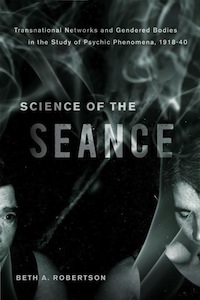I don’t know how many people who pick up this book are reading it for the intended reason. I, like others I’m sure, was attracted by its promise of the occult. You could say that the title, Science of the Seance is a bit of a tease, as this book’s emphasis is really on the science over the seance. That being said, Beth A. Robertson’s balance of an academic and more relaxed writing is an easy read.
The introduction, aptly named “Groping in the Dark,” sets the context for the book. In the opening sentence, Robertson writes, “the subject of this study remains wedged between discourses of science and religion, matter and mind, materialism and metaphysics.” Robertson maps interest in spiritualism, picking up at the end of the First World War. This post-war period, which saw mass grieving for soldiers and civilians, and which simultaneously saw advances in scientific method and more interest in psychology, marked an end of innocence. Although spirits had been summoned into salons for entertainment since the Victorian age, the seance became more interactive, more visceral and more urgent. Over the 20+ years that Robertson documents, the format of the seance changed dramatically. The mediums and the messages that passed through them reflected issues of the day that deeply divided and challenged society norms around gender, class and body politics.
The first medium the reader is introduced to is “Margery,” or Mina Stinson Crandon, who became internationally renown after her husband, a surgeon, recognized her talent for communicating with spirits in the early ‘20s. She channeled the spirit of her brother, Walter, who himself became a figure of note. Walter would appear through other mediums as well, including William Cartheuser, who famously channeled the voices of spirits through a trumpet. The surge of interest in communicating with the dead led to the founding of spiritualist retreats and research centres across North America and Britain. Dedicated researchers came together as the American Society for Psychical Research (ASPR), and circulated publications to share their findings. Some psychical researchers invented machines they believed could record empirical data to verify the seance, but they always had their skeptics.
Simply put, Science of the Seance is a study of the methods employed to measure spiritual activity, and the way these methods scrutinized, oppressed, and at times tortured the bodies of spirit hosts. Robertson does not question the validity of the seance itself, but the validity of the research around it, and the motivations of the researchers. The gender divide between mediums and scientists becomes increasingly apparent and increasingly relevant as this book progresses.
In the chapter, “Fragments of a Spectral Self,” Robertson writes, “much as the medium’s mind seemed in constant danger of pathological illness, so too did her body. Both required close monitoring by trained and predominantly male professionals. Through this lens of sickness and medical expertise, psychical investigators in turn justified their access to and close examination of the medium.” In graphic detail, Robertson describes the examination methods of researcher T. Glen Hamilton, and reprints his observations of an unconscious medium: “Jaw rigidly fixed. Eyeball is insensitive. No twingings of the eyelids. No sign of respiration. Pulse about 78. Rigidity at pelvis and knees absolute. Arms now more limp. Chin still set … Completely insensible.”
I would like to add to my earlier statement. While this book is an easy read, it is not a light read. I put Science of the Seance down angry, less consumed by spectral manifestations than the eternal manifestations of patriarchy and misogyny. While the content of this study is frustrating at times, this book is an invaluable critique of a scientific approach to the paranormal during an era that is often celebrated for its technological and medical advancements. For those interested in gender studies and all things supernatural, Science of the Seance is a must-read.


